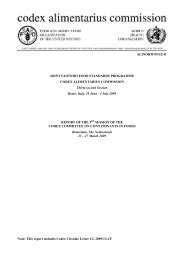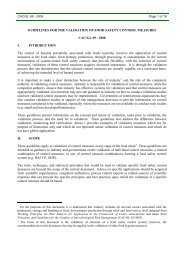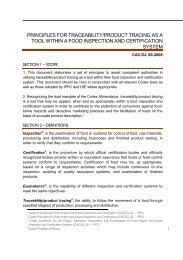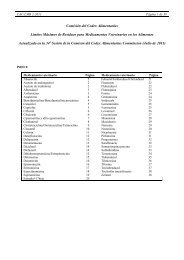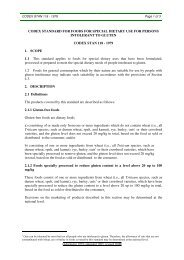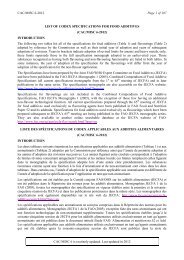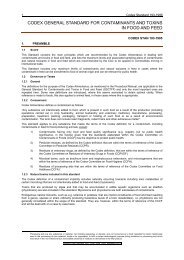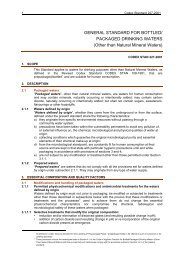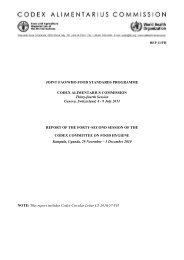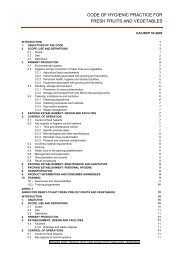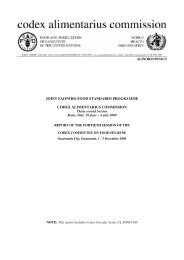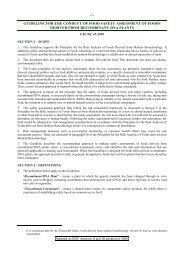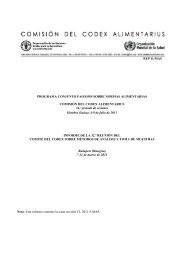General Standard for Food Additives - CODEX Alimentarius
General Standard for Food Additives - CODEX Alimentarius
General Standard for Food Additives - CODEX Alimentarius
You also want an ePaper? Increase the reach of your titles
YUMPU automatically turns print PDFs into web optimized ePapers that Google loves.
<strong>CODEX</strong> STAN 192-1995 Page 43 of 287<br />
14.1.1 Waters:<br />
Includes natural waters (14.1.1.1) and other bottled waters (14.1.1.2), each of which may be non-carbonated<br />
or carbonated.<br />
14.1.1.1 Natural mineral waters and source waters:<br />
Waters obtained directly at the source and packaged close to the source; are characterized by the presence of<br />
certain mineral salts in relative proportions and trace elements or other constituents. Natural mineral water<br />
may be naturally carbonated (with carbon dioxide from the source), carbonated (with added carbon dioxide<br />
of another origin), decarbonated (with less carbon dioxide than present in the water at the source so it does<br />
not spontaneously give off carbon dioxide under conditions of standard temperature and pressure), or<br />
82<br />
<strong>for</strong>tified (with carbon dioxide from the source), and non-carbonated (contains no free carbon dioxide).<br />
14.1.1.2 Table waters and soda waters:<br />
Includes waters other than natural source waters that may be carbonated by addition of carbon dioxide and<br />
may be processed by filtration, disinfection, or other suitable means. These waters may contain added<br />
mineral salts. Carbonated and non-carbonated waters containing flavours are found in category 14.1.4.<br />
Examples are table water, bottled water with or without added minerals, purified water, seltzer water, club<br />
soda, and sparkling water.<br />
14.1.2 Fruit and vegetable juices:<br />
This category applies only to fruit and vegetable juices. Beverages based on fruit and vegetable juices are<br />
found in food category 14.1.4.2. Fruit-vegetable juice blends have separate classifications <strong>for</strong> each<br />
component (i.e., fruit juice (14.1.2.1) and vegetable juice (14.1.2.3)).<br />
14.1.2.1 Fruit juice:<br />
Fruit juice is the unfermented but fermentable liquid obtained from the edible part of sound, appropriately<br />
mature and fresh fruit or of fruit maintained in sound condition by suitable means. The juice is prepared by<br />
suitable processes, which maintain the essential physical, chemical, organoleptical and nutritional<br />
characteristics of the juices of the fruit from which it comes. The juice may be cloudy or clear, and may have<br />
restored (to the normal level attained in the same kind of fruit) aromatic substances and volatile flavour<br />
components, all of which must be obtained by suitable physical means, and all of which must have been<br />
recovered from the same kind of fruit. Pulp and cells obtained by suitable physical means from the same kind<br />
of fruit may be added. A single juice is obtained from one kind of fruit. A mixed juice is obtained by<br />
blending two or more juices or juices and purees, from different kinds of fruit. Fruit juice may be obtained,<br />
e.g., by directly expressing the juice by mechanical extraction processes, by reconstituting concentrated fruit<br />
juice (food category 14.1.2.3) with water, or in limited situations by water extraction of the whole fruit (e.g.,<br />
83<br />
prune juice from dried prunes). Examples include: orange juice, apple juice, black currant juice, lemon<br />
juice, orange-mango juice and coconut water.<br />
14.1.2.2 Vegetable juice:<br />
Vegetable juice is the liquid unfermented but fermentable product intended <strong>for</strong> direct consumption obtained<br />
by mechanical expression, crushing, grinding, and/or sieving of one or more sound fresh vegetables or<br />
vegetables preserved exclusively by physical means. The juice may be clear, turbid, or pulpy. It may have<br />
been concentrated and reconstituted with water. Products may be based on a single vegetable (e.g., carrot) or<br />
blends of vegetables (e.g., carrots, celery).<br />
14.1.2.3 Concentrates <strong>for</strong> fruit juice:<br />
Concentrated fruit juice is the product that complies with the definition given in food category 14.1.2.1. It is<br />
prepared by the physical removal of water from fruit juice in an amount to increase the Brix level to a value<br />
at least 50% greater than that established <strong>for</strong> reconstituted juice from the same fruit. In the production of<br />
juice that is to be concentrated, suitable processes are used, and may be combined, with simultaneous<br />
diffusion of the pulp cells or fruit pulp by water, provided that the water-extracted soluble fruit solids are<br />
added in-line to the primary juice, be<strong>for</strong>e the concentration procedure. Fruit juice concentrates may have<br />
restored (to the normal level attained in the same kind of fruit) aromatic substances and volatile flavour<br />
82 Codex <strong>Standard</strong> <strong>for</strong> Natural Mineral Waters (<strong>CODEX</strong> STAN 108-1981).<br />
83 Codex <strong>General</strong> <strong>Standard</strong> <strong>for</strong> Fruit Juices and Nectars (<strong>CODEX</strong> STAN 247-2005).



